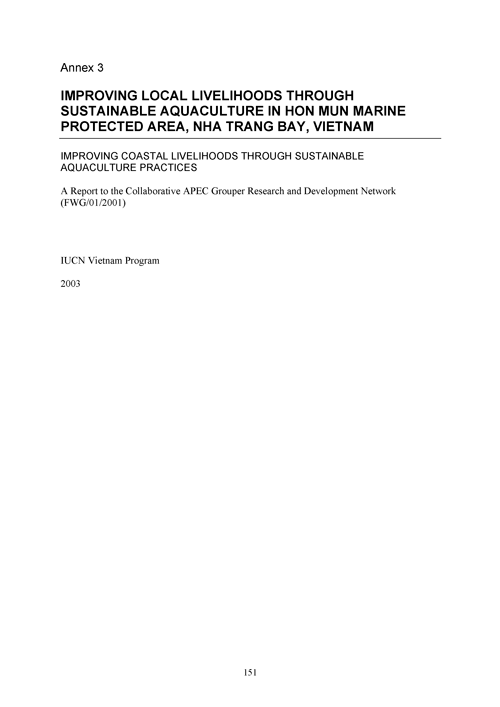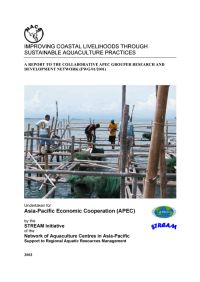Improving local livelihoods through sustainable aquaculture in Hon Mun Marine Protected Area, Nha Trang Bay, Vietnam
3 February 2004 | IUCN Vietnam Program | 1013 Downloads | .pdf | 376.38 KB | Aquatic plants, Crabs and lobsters, Gender, Livelihoods, gender and social issues, Marine finfish, Molluscs (shellfish and other), Vietnam
This case study describes the present status and trends, and provides recommendations for the improvement of aquatic resources management within Hon Mun Marine Protected Area (MPA), Nha Trang Bay, Khanh Hoa Province, Vietnam. The case study also evaluates options for improving the livelihoods of local villagers through the development of ecologically sustainable aquaculture and fisheries, which include diversification following careful selection and trial of appropriate culture species, and application of “best practice” culture methods.
Hon Mun MPA, the first comprehensive MPA in Vietnam, encompasses some 160 km2, including nine islands and their surrounding waters, and supports a resident population of some 5,138 people, the vast majority of whom rely on fishing and related activities as the primary basis of their livelihoods. The MPA has two key roles: improvement of local livelihoods and conservation of the outstanding biodiversity. By successfully combining these two goals, Hon Mun MPA thereby provides a model or “pilot project” for the development of future MPAs in Vietnam.
With over-exploitation and depletion of traditional wild-caught fisheries, villager livelihoods are becoming increasingly focused on developing aquaculture. Since establishment of the MPA, access to some traditional fishing grounds has been restricted to replenish wild stocks, with the associated socio-economic impacts being borne mainly by MPA residents. Many residents consider aquaculture among the most suitable options for additional livelihoods and have raised concerns about access rights to areas suited to aquaculture development.
To date, village aquaculture has focused on cage culture for reef lobster and marine fish, resulting in an increased demand for wild-caught “seed” and “feed”, which is well beyond the ecological sustainability of natural stocks within the MPA and in surrounding waters. Thus, although lobster and marine fish culture remain profitable, their sustainability appears to be short-lived. Similarly, areas suitable for the existing culture system are limited and in some locations cage culture is already at or near local carrying capacity.
The main issues concerning the promotion of local livelihoods through sustainable aquaculture practices can be categorised as: 1. Technical issues: use of wild-caught seed, trash fish and other low-value commodities for feeding; monoculture; disease; application of simple culture technologies that limit suitable areas for aquaculture 2. Environmental planning and management issues: inadequate planning and zoning; lack of supporting legislation (regulations, codes of practice) 3. Economic issues: lack of capital; unstable, developing markets, and 4. Social issues: poverty, inequitable opportunities for local resource users.
These issues are being addressed to develop sustainable aquaculture in Hon Mun MPA. Various criteria were developed to assess the suitability of different species. The criteria emphasise the need for sustainability, integrated planning and minimising adverse environmental impacts, and have been discussed widely with local communities.
The Hon Mun MPA Project (the Project) has planned and implemented a series of aquaculture trials to demonstrate the feasibilities of species diversifications, the use of hatchery-produced seeds, and species that feed successfully from natural food sources or formulated pellets.
Among the 15 candidates, trials have been implemented for species such as seaweed (Kappaphycus alverezii), green mussel (Perna viridis), sandfish (Holothuria scabra), rabbit fish (Siganus guttatus) and groupers (Epinephelus malabaricus and E. tauvina). To date, most trials have shown success, indicating that there is a wide variety of species other than lobster and marine fish that have the potential of being cultured successfully to help improve livelihoods of local villagers.
To further assist planning and management of sustainable aquaculture in MPA waters, the “Hon Mun MPA Aquaculture Masterplan” (the Masterplan) will be developed as an integral part of the Hon Mun MPA Regulation and Zoning Scheme, minimising conflicts with other resource users in the MPA, and providing guidance to local villagers. The Masterplan will establish zones for the culture of different species within the MPA and identify the carrying capacity of each proposed aquaculture site. The Masterplan will also seek to balance the different types of species cultured and to develop an integrated system where environmental impacts are minimised. As part of this approach, an integrated culture system – with sandfish (detritus feeders) cultured underneath lobster or marine fish (carnivores) cages – is being developed. Although the trial system is yet to be completed and evaluated, the concept is sound and good results are expected. While further research and development of various sustainable aquaculture systems is beyond the scope of the present Project, efforts will be made to enhance the active involvement of national aquaculture research institutions through recommendations and coordination of expertise and resources.
Given the limited spatial extent of areas suitable for existing culture systems within MPA waters, it is proposed that priority allocation of sites be provided to local people seeking to undertake aquaculture activities. Local people will then have the opportunity to lease their rights to investors from outside the MPA. Extension services will also be crucial in assisting local aquaculture farmers and fishers in sustainable aquaculture development and fisheries management in general.
Even with all the above measures in place, the limited spatial extent of areas suitable for existing culture systems, combined with technological, financial and social constraints, mean that aquaculture alone will not provide sufficient additional or alternative income for all local villagers. To this purpose, the Project is also promoting sustainable fisheries coincidentally with aquaculture development. These MPA management initiatives include implementation of core “no-take” zones for fisheries replenishment at key locations to restore depleted wild fish, crustacean and shell-fish stocks, with likely fishery benefits of larval replenishment and adult “spill-over” into adjacent fishing zones. If successful, these initiatives, with the other additional income streams being developed, should help to ensure improved livelihoods for local villagers and conservation of the MPA’s outstanding biodiversity attributes.
Copyright, all rights reserved.

